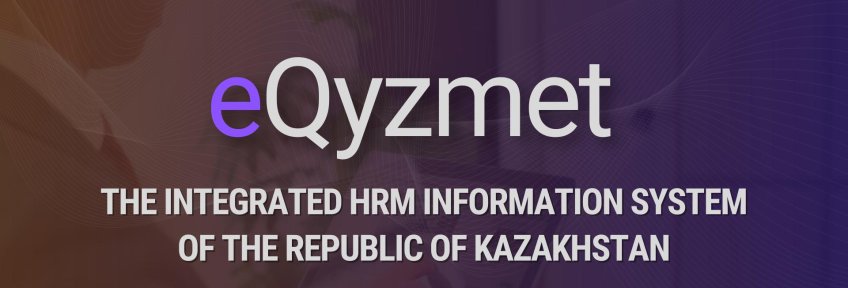“e-Qyzmet” is a central element of Kazakhstan’s digital public administration, fully automating HR processes and supporting national human resources policy.
By centralizing data and ensuring transparent recruitment, evaluation, and promotion, it eliminates favoritism and boosts meritocracy.
Covering 400+ HR processes across government bodies, the system enhances accessibility and sustainability in civil service.
Innovation Summary
Innovation Overview
“e-Qyzmet” system is a centralized digital platform designed to automate all HR processes within the civil service of the Republic of Kazakhstan.
Prior to its implementation, HR administration in government agencies was fragmented, paper-based, and lacked sufficient transparency. Between 2013 and 2015, the system’s architecture was developed, covering more than 400 business and HR processes across all state bodies. In 2022, the mobile self-service module e-HRM was launched, and by 2023, the system had achieved full automation and eliminated paper-based documentation.
The core goal of this innovation is to create a transparent, efficient, and sustainable human resource management system in the public sector.
The system has automated application submissions, personnel transfers, data storage and transmission, as well as procedures for dismissal and reinstatement in civil service.
Moreover, “e-Qyzmet” mitigated corruption risks in recruitment through an external online portal that ensures equal access to vacancies, facilitates competitive selection, and digitally records every step of the process.
It also introduced an electronic performance evaluation system based on KPIs and provides real-time access to up-to-date HR statistics.
Three key user groups have benefited from the system:
• Civil servants gained access to electronic self-service functions (e.g., leave requests, business trip applications).
• HR departments were equipped with tools for quick access to and updating of information, recruitment, and talent pool development.
• Citizens and job applicants now have access to a transparent, objective, and easily accessible mechanism for participating in open competitions for civil service positions, regardless of their place of residence. This has increased trust in the system and improved the fairness of HR decisions.
In the future, “e-Qyzmet” is expected to be institutionalized as a unified digital HR ecosystem for the entire public administration.
The platform’s capabilities will be further expanded through the integration of advanced HR analytics, personalized digital profiles for civil servants, and interoperability with other state information systems.
In doing so, the system will continue to support the development of a professional, results-oriented, and sustainable civil service aligned with Kazakhstan’s strategic sustainable development goals.
Innovation Description
What Makes Your Project Innovative?
“e-Qyzmet” initiative is a unique solution with no analogues in Kazakhstan’s public administration.
For the first time, all HR processes have been consolidated into a single digital system encompassing over 400 procedures.
Thanks to the introduction of digital HR analytics, the preparation of annual reports now takes 15 minutes instead of a full week.
Online recruitment removes geographical and administrative barriers, making competitive selection accessible to all.
The system’s innovation is also evident in enhanced transparency: disciplinary procedures, performance evaluations, and promotions are recorded and traceable within the platform, reinforcing meritocracy.
This project has transformed the perception of HR departments—from bureaucratic obstacles to transparent and effective management tools.
What is the current status of your innovation?
“e-Qyzmet” system is currently in an active phase of implementation and scaling.
It covers all government agencies, HR departments, and citizens across Kazakhstan.
In 2024, the support service processed over 18,000 requests:
– 7,257 via Jivo chat,
– 1,440 by phone,
– 9,998 through online platforms.
The external portal provides 24/7 access to civil service vacancies, while the internal portal is used within government agencies.
The system has proven its effectiveness: by fully recording all processes, it has helped reduce corruption risks, enhance transparency, accelerate recruitment, and strengthen public trust in the civil service.
Efforts are underway to integrate artificial intelligence and machine learning for forecasting HR needs, personalized recruitment, and talent development, paving the way for the continued transformation of Kazakhstan’s public sector HR system.
Innovation Development
Collaborations & Partnerships
The key coordinator of the project is the Agency for Civil Service Affairs of the Republic of Kazakhstan, which is responsible for strategic management, regulatory framework, and resource allocation.
The Academy of Public Administration provides technical support, monitoring, testing, and user feedback.
Hosting is managed by the Unified Server Center, operated by “National Information Technologies” JSC, ensuring the system’s security and protection from unauthorized access by third parties.
Users, Stakeholders & Beneficiaries
“e-Qyzmet” system serves civil service candidates, civil servants, HR departments, and government bodies. Candidates apply fully online via the External Portal.
• Civil servants manage leave, evaluations, and career growth.
• HR units handle records, reports, and automate orders.
• Government bodies use analytics for workforce planning.
Each group benefits from tailored digital tools, improving efficiency and reducing paperwork.
Innovation Reflections
Results, Outcomes & Impacts
“e-Qyzmet” system is a cornerstone of Kazakhstan’s digital transformation in public administration and a key instrument for implementing national HR policy.
It integrates all HR processes into a unified platform, providing centralized access to civil servant data and enabling more informed managerial decision-making.
The system enhances transparency and accountability: by automating recruitment, evaluation, and promotion processes, it reduces corruption risks and reinforces merit-based principles.
This, in turn, increases public trust in the civil service system.
In the long term, “e-Qyzmet” supports debureaucratization, increases management flexibility, and helps build a professional and resilient civil service essential for the country’s strategic development.
Challenges and Failures
Several key challenges emerged during the development and implementation of the “e-Qyzmet” system.
In the early stages, resistance was observed among civil servants who were unprepared for the transition to digital tools, which slowed down the adoption of automated processes.
This created a need for extensive user training and efforts to improve digital literacy across the public sector.
The first version of the system had a monolithic architecture, which limited its flexibility and made updates difficult. In 2017–2018, a redesigned version was developed with an improved user interface and modular architecture, significantly enhancing its adaptability and user-friendliness.
Another major challenge was integrating “e-Qyzmet” with other government systems, which required ensuring compatibility and operational stability.
Gaps in HR analytics and strategic planning were later addressed through the introduction of automated reporting modules and forecasting tools for human resource needs.
Conditions for Success
The success of the “e-Qyzmet” system was made possible through the combination of technical, human, financial, and institutional resources.
The use of modern IT solutions and migration to cloud hosting - ensured cost savings, greater flexibility, and enhanced system resilience.
The platform is integrated with more than 100 government systems, including databases of individuals, access control systems (ACS), and the national pension center.
The project involved a wide range of specialists, including developers, system analysts, HR managers, and support services.
State budget funding enabled the modernization of equipment and the enhancement of software functionalities.
Coordination by the Agency for Civil Service Affairs, the Academy of Public Administration, the Ministry of Digital Development, and other key stakeholders ensured strong institutional backing and the successful integration of “e-Qyzmet” into Kazakhstan’s public administration system.
Replication
Following the launch of the External Portal of the “e-Qyzmet” system in 2022, a pilot project was implemented in three central and two local executive bodies.
Based on its successful outcomes, the portal was rolled out for full-scale operation in 2024, initiating the phased nationwide expansion of the new digital recruitment system.
Today, this digital selection mechanism is operational across all government agencies, ensuring transparency and accessibility of competitive processes.
As a result, the innovation has been successfully replicated to address similar challenges throughout the entire public administration system.
Lessons Learned
Important lessons were learned during the development and implementation of the “e-Qyzmet” system, which contributed to its continuous improvement.
The first lesson was the need for a simplified user interface.
In the early stages, the system’s complexity created difficulties for users, especially those without technical backgrounds.
This was addressed through interface redesign, user training, and continuous support.
The second was the importance of data quality. Errors during manual data entry highlighted the need for automation and validation. As a result, data verification mechanisms and integration with external databases were introduced.
The third lesson was the critical value of flexible integration with other government agencies. Initial challenges with system compatibility led to the development of a more robust data exchange architecture.
These insights significantly enhanced the system’s adaptability, usability, and long-term sustainability.
Anything Else?
“e-Qyzmet” system is a strategic HRM tool in Kazakhstan, demonstrating strong resilience through sustained government support and institutional backing.
Continuous monitoring and modernization enable the system to adapt to evolving public administration needs.
Technological resilience is ensured via a shift to cloud-based solutions and the integration of AI elements.
Regulatory resilience is maintained through compliance with legislation and timely updates.
The system helps cut costs by reducing paper-based processes and aligns with Kazakhstan’s digital government strategy.
Civil service candidates have responded positively, as shown in social media feedback, and a 2024 survey recorded 67% satisfaction among HR departments.
In 2023, a regional study by the Astana Civil Service Hub and UNDP, covering Kazakhstan, Kyrgyzstan, Uzbekistan, and South Korea, assessed the capacity and potential of “e-Qyzmet,” confirming its value as a robust e-HRM platform.
Project Pitch
Supporting Videos
Status:
- Evaluation - understanding whether the innovative initiative has delivered what was needed
Date Published:
21 November 2025


